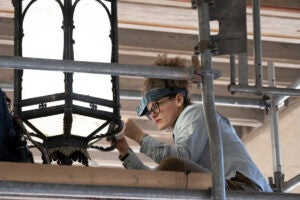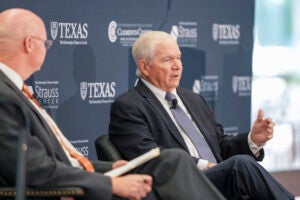
Plans finalized and ground broken, a team of University of Texas at Austin students is on track — rain and shine — to finish constructing a solar-powered home this fall for an elite international competition.
More than 60 students from UT and the Technische Universität München (TUM) in Germany have spent the past two years designing and building “Nexushaus” for the U.S. Department of Energy’s Solar Decathlon competition.
The Nexushaus team is one of 20 selected for the prestigious competition out of more than 150 teams that applied, and they’re not letting recent rains in Austin throw the last five months of the competition off track.
In October, they’ll ship the modular home to California, where judges will score everything from architecture and engineering to the performance of home appliances, affordability and how well the teams market and promote the solar-powered homes.
“We’ll get it all done, but it’s going to be a tighter timeline than we hoped for initially,” says Ph.D. student Charlie Upshaw, one of the team’s co-captains who also oversees mechanical and water systems on the project. “I’d prefer to be farther along than we are, but some of the delays, like the weather, have been out of our control.”
[To learn more about the Nexushaus team, read “Raise the (Solar) Roof: Students Building Solar Home.”]
Since submitting a stack of 500 pages of drawings and detailed planning documents to the U.S. Department of Energy in February, the team has started construction at a site near UT’s baseball and softball fields. They’ve built an aquaponics system and welded the modular home’s frame to an undercarriage so it can be driven to California for the competition. The next step is putting a roof on the house, followed by electrical and plumbing work and finishing the interior.
By UT’s first home football game in September, the team will clear the construction site to make way for tailgaters, and they’ll prepare the house to be shipped to Irvine, Calif., where the judging takes place.
[Want to help the team compete? Donate to The University of Texas at Austin and Technische Universität München’s 2015 Solar Decathlon Team. If you have services or materials to donate, visit the Nexushaus material donations page for more information. Or, if you want to help with construction, contact Nexushaus Project Manager Megan Recher.]
Among the UT students on the Nexushaus team, 41 are from the Cockrell School of Engineering, 36 are from the School of Architecture, four are from the McCombs School of Business, three are from the College of Liberal Arts and there is one each from the Jackson School of Geosciences, the College of Natural Sciences and the Moody College of Communication.
Here’s what three of the UT students have to say about working on the Solar Decathlon team and collaborating with Longhorns from across the Forty Acres:

Kaitlyn Gruener, architecture senior
Expertise: As the team’s health and safety officer, Gruener completed a 30-hour Occupational Safety and Health Administration certification, authored the team’s health and safety plan and holds safety training sessions that are required for students who work on the construction site.
What she says: “Within the school of architecture, we have both architecture and interior design majors working on the project. When the inside of the house needed some love, the interior design students were able to step in and take over from the architecture students working on the overall design. Being able to divide and conquer is essential to this project because there is such a depth of things to complete and many deadlines we have to meet for the Department of Energy.
“This project really couldn’t work if it was just a single degree program trying to take this all on. For me, this project has been a blessing in disguise. I never knew how interesting I’d find the health and safety side of the construction site, and it’s something I’ve been seriously considering trying to follow up on after I graduate.”

Kerri Murphy, second-year MBA
Expertise: Murphy is working on the team’s performance in the marketability part of the competition and is developing a plan to potentially commercialize the Nexushaus model after the competition.
What she says: “It is one thing to stand in front of a room of MBAs and present on a topic or subject with which they all may be familiar. It is very different to explain those same business concepts, and how they might be applicable to a project like this, to engineers and architects. Opportunities to collaborate in this manner help to make our skills more marketable post-graduation.
“I had some exposure to the solar industry through coursework at McCombs, but working on the Nexushaus team has helped me learn a great deal more about the technical aspects, and I was able to add to the team through my understanding of the economics and business.”

Julia Park, architectural engineering and architecture senior
Expertise: With a background in engineering and architecture, Park works as the smart home team leader and oversees sustainable design features.
What she says: “In the workplace, you’re not just solving specific, narrow problems out of a textbook — everyone from all disciplines works together to solve problems.
“I’ve learned so much from working with these amazing peers from engineering, business, architecture and elsewhere. It’s kind of like taking advantage of the education UT offers rather than just what your specific college offers. It also lets me explore and refine my academic interests — I knew I was interested in computer science, but now I’m seriously considering pursuing it later in my career.
“I could go on and on about the things I’ve learned from my peers, but what jumps out at me is the importance of marketing and business strategies. I have the engineering and architecture backgrounds, but I didn’t know anything about that particular skill set.”
[Keep up to date on the Nexushaus team by following progress on Facebook, Instagram and Twitter.]

This story is part of our “Finding Solutions” series, which explores how UT Austin faculty, staff and students are putting their big ideas to work.



